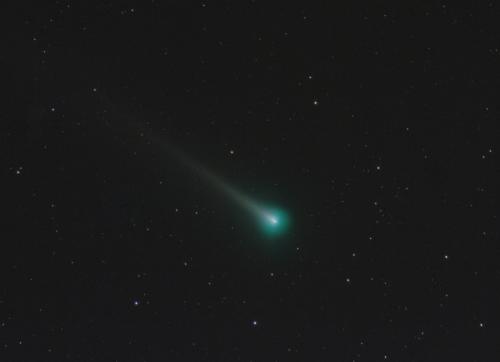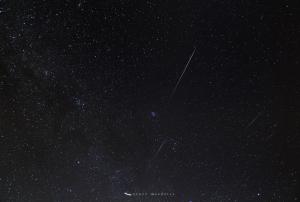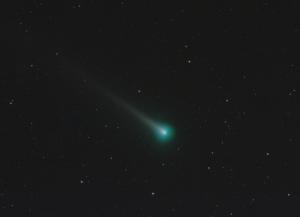Celebration of Space - December 10, 2021

Comet C/2021 A1 Leonard on Tuesday, December 7, 2021 by Frosty Drew Astronomy Team member, James Crouch.
This coming Monday, December 13, 2021 and lasting until sunrise on Tuesday, December 14, 2021 the annual Geminid Meteor Shower peak will occur. Hands down the best meteor shower of the year, the Geminids can bring upwards of 200 additional meteors per hour to regular meteor activity. For 2021 we have the Moon for the first half of the night, but once the Moon sets, the sky will light up with shooting stars.
The Geminid shower is a product of a potentially defunct comet named 3200 Phaethon, now classified as an asteroid. 3200 Phaethon has left a rather dense debris field of ice that follows its orbit around the Sun, and intersects Earth’s orbital path. Every December we pass through this debris field causing the tiny particles of ice to get caught in Earth’s gravity, and enter the atmosphere at a rate of 21 miles per second. At that rate, these particles will burn up when encountering Earth’s atmosphere. When looking to the sky, all meteors will appear to radiate from the constellation Gemini, just to the NW of the bright star Castor. This is where the shower gets its name from, and that point is called the radiant point, which is where you do not want to be looking during the shower.
Observing the Geminid peak in 2021 will not initially be as awesome as past years, and that is because the bright 85% waxing gibbous Moon will be out at sunset. Predictions of 200 meteors per hour are only applicable on nights with super clear sky conditions, no Moon, no artificial light, and when the radiant point is closest to the zenith (top of the sky). So we are not expecting that level of visible meteor activity this year. But one of the bonuses of the Geminid peak is that the radiant point is already above the horizon after sunset, and will stay up nearly all night. Considering that the Winter Solstice is about two weeks away, we get a super long period of night to lay out and enjoy the shower. The Moon will obscure all but the brightest meteors at first, but the Moon will set at 2:39 am Tuesday morning, leaving over three hours of dark sky viewing in the morning to catch a stunning show. Unlike other meteor showers, which appear to experience a lull at some point overnight, the Geminids will rip all night long.
There are several ways to catch a view. If shooting for the evening hours, just step outside, lay on your back with your feet to the south and look to the zenith to catch brighter meteors shooting by. Even though the Moon is bright, the Geminids are active enough to still bring a good display. For those who are looking to catch the shower in the morning after the Moon sets, you will want to be at a dark location largely free of light pollution. Lay on your back with your feet to the south and look to the zenith. Frosty Drew Observatory and Science Center will be hosting an event for the meteor shower and will open around 6:30 pm. At first we will have the Observatory telescope open and available to observe through, but as the shower picks up we will move outside so all can get a good view. Being in the observatory dome will make it difficult to spot Geminid meteors. Team members will be on site for the entire night, highly anticipating the Moon set. At this time, weather forecasts look really good for that entire night. So put it on your calendar and say farewell to autumn under the best meteor shower of the year.
Now that the PlaneWave CDK600 telescope in the Frosty Drew Observatory is operational, we have been working our way through our extensive list of issues. Note that this is not a list of problems, it’s a list of regular, expected, issues that we have identified. Over the past three weeks we have significantly increased the quality of the view by performing additional optical alignments. We have also been working out our software issues and, just this past week, replaced the old control computer that we migrated over from the Meade LX200 telescope, which could not handle the load that the PlaneWave components put on the PCIe bus. Some of the items that remain on our list address the height of the eyepiece issue. Being that the telescope has a significantly larger aperture, the placement of the eyepiece (center of the telescope diameter) is quite higher off the viewing platform. When viewing objects that are lower in the sky this results in a bit of a climb up the step ladder. Those who are a bit vertically challenged (like me) end up having trouble reaching the eyepiece. Another issue is the integration of a diagonal, which will make it easier to observe around the zenith and will help with the height of the eyepiece issue. The CDK design uses a fixed primary mirror, which seriously reduces our ability to focus the telescope. We are currently having trouble integrating a diagonal due to our spacer set up. Perhaps we will fix this tonight? Regardless, the telescope is quickly moving to fully operational status, and our list is getting shorter by the day.
This past week, Comet C/2021 A1 Leonard has been putting on quite a show for early morning sky watchers. With a nice bump in brightness, to magnitude 6.6, the comet is easily visible in binoculars and small backyard telescopes. The difficulty with viewing comes down to artificial light (light pollution). Comet’s tails are very tenuous, and the atmosphere that forms around the comet’s nucleus, called a “coma”, is also a bit dim. Both are easily obscured by moonlight and artificial light. Now that the comet has moved into the pre-dawn morning sky, it will become a bit harder to observe. Comet Leonard will make its closest approach to Earth on Monday, December 13, 2021, after which the comet will move into our evening dusk sky. Since the comet is still making its way towards the Sun, with perihelion (closest to the Sun) occurring on January 3, 2022, the comet should continue to brighten. We’ll keep an eye on the comet at Frosty Drew, and if we feel it is brightening to a good view, we will host special events to view the comet. So keep a close eye on our events calendar. Check out this photo that Frosty Drew Astronomy Team member James Crouch captured this past Tuesday morning (December 7, 2021). Comet A1 Leonard will be the brightest comet of 2021.
The last evening pass of the International Space Station (ISS) over our region for 2021 will occur tonight. But thanks to the China National Space Administration (CNSA), we now have another space station in orbit, Tiangong, which will be offering evening passes over our region for the next three weeks. Though not as bright as the ISS, Tiangong is easily visible and brighter than most satellites. Here is the last pass of the ISS for the year:
Fri, Dec 10 at 4:44 pm, starting in the WNW, rising to 37°, heading towards the SSE
Here are notable Tiangong passes in store for sky watchers this week:
Fri, Dec 10 at 6:13 pm, starting in the WSW, rising to 52°, and into orbital sunset
Sat, Dec 11 at 5:12 pm, starting in the WSW, rising to 50°, heading towards the E and into orbital sunset
Sun, Dec 12 at 5:49 pm, starting in the W, rising overhead, heading towards the E and into orbital sunset ← Awesome pass!
Mon, Dec 13 at 4:48 pm, starting in the WSW, rising to 70°, heading towards the E ← Awesome pass!
Tue, Dec 14 at 5:25 pm, starting in the W, rising overhead, heading towards the E and into orbital sunset ← Awesome pass!
Wed, Dec 15 at 6:01 pm, starting in the W, rising to 80°, and into orbital sunset ← Awesome pass!
Thu, Dec 16 at 5:00 pm, starting in the W, rising overhead, heading towards the E ← Awesome pass!
Even though the ISS is departing our evening sky, Tiangong has several fantastic viewing opportunities in store. These times are for Southern New England, and generally applicable for the entire Northeast. For daily pass times of bright satellites visit the Frosty Drew Daily Satellite Pass Prediction utility. Now get out there and see some amazement!
- Author:
- Scott MacNeill
- Entry Date:
- Dec 10, 2021
- Published Under:
- Scott MacNeill's Columns





